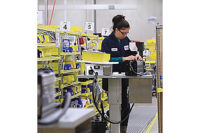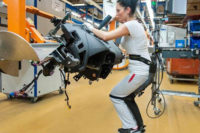Training Improves Ergonomics at Window Manufacturer

Window manufacturers should take a proactive approach to environmental health and safety.
Photo by Anatoliy Cherkas, courtesy Getty Images
Window and door manufacturing is surprisingly hazardous.
According the U.S. Bureau of Labor Statistics, manufacturers of windows and doors reported 4.2 nonfatal occupational injuries and illnesses per 100 workers in 2023, the latest year for which data is available.
That compares with 3.4 in transportation equipment manufacturing, 3.2 in furniture manufacturing, 2.7 in machinery manufacturing, 2 in electrical equipment and appliance manufacturing, 1.6 in medical device manufacturing, and 0.9 in electronics manufacturing.
Assemblers of windows and doors are exposed to various hazards common in many manufacturing environments, including injuries from moving objects or slips, trips and falls. But, workers in the fenestration industry have additional safety concerns, including safely handling large, awkward and heavy sheets of glass; cuts from sharp edges of glass or tools; exposure to dust and flying particles from cutting, grinding, drilling and polishing glass; and exposure to solvents in adhesives, sealants and etching chemicals.

Pushing, pulling, lifting and bending motions are consistently performed as a part of daily job functions. Photo by Gorica Poturak, courtesy Getty Images
Recently, management at a major window and door manufacturer decided to do something about it. The company employs thousands of people at several factories across the United States. Although the company also installs the products it makes, management wanted to focus initially on improving safety at the company’s production facilities.
The manufacturer called on the DORN Companies for help at three of its factories in California. Based in Highlands Ranch, CO, a suburb of Denver, DORN provides ergonomics, wellness and injury-prevention services. The company takes a proactive approach to environmental health and safety, harnessing the latest research to develop effective, data-driven injury prevention and wellness programs. The company’s customers include Collins Aerospace, Emerson, Intel and bootmaker Wolverine Worldwide.

Manufacturers of windows and doors reported 4.2 nonfatal occupational injuries and illnesses per 100 workers in 2023. Photo by DuxX, courtesy Getty Images
At the window manufacturer, chronic pain presented an ongoing problem for the workforce. DORN specialists observed hazards and risk factors in worker technique across all departments. Pushing, pulling, lifting and bending motions were consistently performed as a part of daily job functions, but little training had been offered to educate workers on how to execute those motions without putting themselves at risk of injury.
These problems were exacerbated by the nature of workforce, which had a large share of tenured workers who were 55 or older. Environmental hazards were also a persistent factor, with debris and cluttered workspaces contributing to the risk of injury across each facility. Annual costs related to musculoskeletal injuries and chronic pain were estimated at nearly $2 million across the three sites, not including indirect costs from absenteeism and lost productivity. The business was experiencing incidents at rates in excess of 7 to 9 percent of the workforce.
The Solution
DORN specialists worked with the company’s management to introduce an on-site therapy program targeting musculoskeletal risk factors and chronic pain among workers. DORN created a program that brought specialists onsite weekly at each facility, performing brief 15 to 30 minute PainFree therapy sessions with workers experiencing pain from overexertion, repetitive motion strain, and musculoskeletal conditions. During the sessions, specialists provide targeted treatment for job-related aches and pains, helping to improve tissue health and function while engaging directly with workers.
Additionally, DORN implemented on-site coaching and monitoring services aimed at providing real-time correction for risky behaviors. DORN specialists introduced training sessions to teach employees biomechanical techniques to improve the safety of tasks that require lifting and bending.
 Photo by Blue Cinema, courtesy Getty Images
Photo by Blue Cinema, courtesy Getty Images
Since the initial rollout at the three pilot sites, the manufacturer has reported significant reductions in injury frequency. In particular, employees reported major changes in their pain levels, with reductions estimated at 75 percent from previous levels. The company also reported a 65 percent increase in productivity after a year of using DORN services, and 91 percent of workers surveyed in the program reported significantly improved morale on the job. Likewise, 94 percent of the affected workers reported that it was easier to do their jobs following their PainFree treatments. Finally, the incident rate for those that DORN worked with directly fell by 50 percent or more to under 4 percent.
Based upon the various start dates for each site, the total savings achieved in the first year working with DORN exceeded $600,000. The manufacturer has since expanded the program beyond the original three sites and is looking to expand their service package with DORN’s post-offer employment testing and return-to-work programs.
For more information on ergonomics, read these articles:
Window Assemblers Get a Lift
Industry Report: Household Hardware Manufacturing
Automatic Screwdriving Opens Window to Productivity
Looking for a reprint of this article?
From high-res PDFs to custom plaques, order your copy today!





